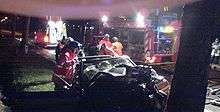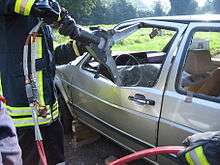Vehicle extrication
Vehicle extrication is the process of removing a vehicle from around a person who has been involved in a motor vehicle accident, when conventional means of exit are impossible or inadvisable. A delicate approach is needed to minimize injury to the victim during the extrication. This operation is typically accomplished by using chocks and bracing for stabilization and hydraulic tools, including the Jaws of Life. Standards and regulations can be found in NFPA 1670 and 1006.
Operations







The basic extrication process consists of, but is not limited to, six steps:
- the protection of the accident scene, to avoid a risk of another collision (marking out the scene with cones or flares (not advisable if gasoline is leaking), lighting) and of fire (e.g. switching off the ignition, putting vehicle in park, disconnecting the battery, placing absorbing powder on oil and gasoline pools, fire extinguisher and fire hose ready to use);
- patient triage and initial medical assessment of the patient by a qualified medical rescuer;
- securing the vehicle (see cribbing), to prevent the unexpected movement (e.g. falling in a ditch), and the movements of the suspension, either of which could cause an unstable trauma wound or cause injury to the rescuers; a vehicle should never be moved, it should always be secured.
- the opening of the vehicle and the deformation of the structure (such as removing a window) to allow the intervention of a first responder, of a paramedic or of a physician inside the vehicle to better assess the patient and begin care and also to release a possible pressure on the casualty;
- removal of a section of the vehicle (usually the roof or door) to allow for safe removal of the accident victim, especially respecting the head-neck-back axis (rectitude of the spine);
- removal of the person from the vehicle
In less complicated cases, it is possible to extricate the casualty without actually cutting the vehicle, such as removing a person from the side door or another part of the vehicle.
As soon as possible, best before beginning the mechanical operation, a medically trained person enters the cabin to perform first aid on the casualty: mid-level assessment, stopping the bleeding, putting a cervical collar on the patient (extrication operations are likely to provoke vibrations), providing oxygen first aid. In France, this rescuer is called the "squirrel" (écureuil). NFPA regulation 1006 and 1670 state that all "rescuers" must have medical training to perform any technical rescue operation, including cutting the vehicle itself. Therefore, in almost all rescue environments, whether it is an EMS Department or Fire Department that runs the rescue, the actual rescuers who cut the vehicle and run the extrication scene are Medical First Responders, Emergency Medical Technicians, or Paramedics, as a motor vehicle accident has a patient involved.
After the vehicle has been secured and access gained to the patient, the EMS team then enters to perform more detailed medical care. Continued protection of the patient from extrication itself, using hard and soft protection, should be done at all times. The deformation of the structure and the section of the roof take several minutes; this pre-extrication time can be used for medical or paramedical acts such as intubation or placing an intravenous drip. When the casualty is in cardiac arrest, cardiopulmonary resuscitation can be performed during the freeing, the casualty being seated. The use of this incompressible duration is sometimes called play and run, as a compromise between scoop and run (fast evacuation to a trauma center) and stay and play (maximum medical care onsite).
The last step is usually performed with a long spine board: the casualty is pulled up on it. An extrication splint (KED) can help to immobilise the spine during this operation.
Extrication, as defined by NFPA must be done by medically certified individuals, and as such, many Rescue teams are run by standalone Emergency medical services departments. In major cities, where fire departments have firefighting/Emergency medical technicians, fire departments can run rescue. In NYC, the police department handles some aspects of rescue. In many rural areas, usually volunteer First Aid Squads handle rescue. In the midwest, there are dedicated Rescue Departments that run neither fire trucks nor ambulances and strictly focus on rescue. There are some departments that are a combination of Fire/EMS, Police/EMS or Rescue/EMS, but the concept is that most organizations that run Rescue have some sort of EMS division or EMT training. As such, Extrications are handled in many ways. Some are by run completely by one organization, such as strictly by an EMS department. Some are a run by a combination department that runs ambulances and fire trucks. Some are run as an inter-agency joint effort. Some are backups to others. And some departments run just a heavy rescue truck. Some departments also might only handle light rescue and door pops, leaving the more complicated rescue and heavy rescue dedicated to a heavy rescue unit.
Extrication includes patient assessment, treatment and removal of the patient from vehicle. Some departments only carry with them minimal tools such as one set of jaws of life and are only capable of simply "popping" a door off and then must step away to allow the medical rescuers in or to allow a more dedicated heavy rescue team in who has more equipment. Extrication units are supposed to not only have many different kinds of extrication tools, but medical equipment, oxygen, and backboards as well. Extrication is the entire process from fire protection, power unit disengagement, vehicle security, patient security and treatment, removal of vehicle from patient, removal of patient, and transfer to ambulance. Extrication is not just simply popping a door off.
Extrication Tools and Equipment
Rescue personnel use a number of tools to extricate victims. There are two main types:
- Hydraulic — Rescue tools powered by a hydraulic pump. The pump may be powered by hand, an electric motor or a gasoline engine. They may be portable or mounted to a vehicle. There are 4 basic types of hydraulic rescue tools. They are spreaders, shears, combination spreader/shears and extension rams.
- Pneumatic — Rescue tools are powered by pressurized air. The pressurized air is sourced from SCBA Cylinders, vehicle mounted cascade systems or vehicle mounted air compressors. Whizzer Saws and Air Chisels are examples of pneumatic-powered tools.
The first step in an extrication is to stabilize the vehicle to prevent aggravating the injuries of the entrapped and to protect rescue workers. This is done by using stabilization tools:
- Hydraulic and nonhydraulic jacks — Designed to lift the vehicle so cribbing can be placed. A vehicle must never be supported by just a jack and must be supported by cribbing. One inch of cribbing must be placed for every inch the jack lifts.
- Buttress Tension System — A buttress tension system is used to stabilize a vehicle resting on its side or top. It may consist of a minimum of three 4 x 4 inch posts wedged between the vehicle and the ground, or it may be a system composed of metal rods and straps. The exact placement varies by the condition and weight of the vehicle as well as what the vehicle is resting on.
- Wheel chock — Wheel chocks are used to stabilize vehicles resting on their wheels. They can support vehicles of a 10 to 15 percent grade. They are commonly constructed of aluminium, hard rubber, wood, or urethane plastic.
- Cribbing — Cribbing consist of wood or plastic blocks that are made in a variety of shapes and sizes.
- Pneumatic Lifting Bag — Pneumatic lifting bags are air-pressurized devices that lift objects. They come in three basic types: high-pressure, medium-pressure and low-pressure. They are usually made with a rubber exterior reinforced with steel wire or Kevlar. When deflated they are about one inch thick.
- Winch — Winches are mounted on vehicles and are typically faster, stronger and have a greater pulling distance than other pulling devices. They are used in conjunction with chains or cables.[1]
Additional risks
Active systems such as airbags make cutting into a vehicle more complicated: when they are not set off during the accident (e.g. in a vehicle struck from the rear or a rollover), extrication operations may set them off. This can cause additional trauma to the accident victim or to the rescuers. Airbags can remain active anywhere from 5 seconds to 20 minutes after being disconnected from the car's battery. This is one of the reasons rescuers disconnect the vehicle's battery and wait before cutting into a vehicle.
New hybrid technologies also include additional high voltage batteries, or batteries located in unusual places. These can expose occupants and rescuers to shock, acid or fire hazards if not dealt with correctly. Some references to the actual nature of the Hazards : Honda Toyota Ford News Summary More.
Some vehicles have an additional autogas (LPG) tank. As the system was not built in, there is a risk of damaging the pipe which is often under the car, releasing the pressurised fuel. The risk of this is minimised by locating the line in a protected position during installation. Modern installations also have a shutoff solenoid at the tank so that rupture will only release the fuel in the line rather than allowing fuel to come out of the tank.
Car manufacturers are using ultra-high-strength steel (UHSS) to achieve the 5-star Government Crash Rating. Vehicles have UHSS areas of the body structure like the A-pillar, B-pillar, rockers, side impact beams, and roof beams. This steel is difficult to cut with the standard extrication tools.
See also
- Hydraulic rescue tools
- Heavy rescue vehicle
- Rescue squad
- Tram accident
- Vehicle recovery
- Firefighting
Notes
- ↑ Essentials of Fire Fighting (6th ed.). Fire Protections Publications Oklahoma State University. pp. 479–549.
External links
- Vehicle Extrication: Levels I & II: Principles And Practice [Paperback]
- Ron Moore's University of Extrication on Firehouse.com
- Extrication information on Vehicle Body Structures
- iRescue: App for iPhone/iPad to help the emergencie professionals to get information about a car in rescue situations
- Vehicle extraction technics (PDF file, 70p, 4.9 Mb)
